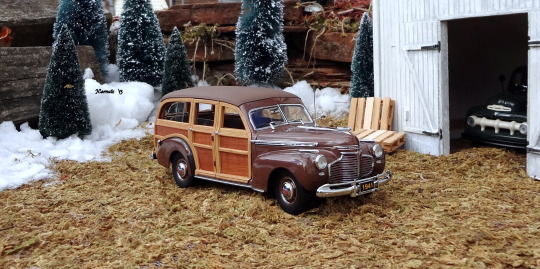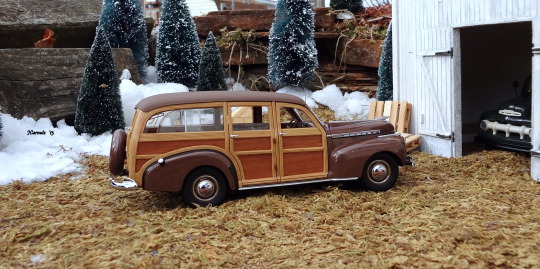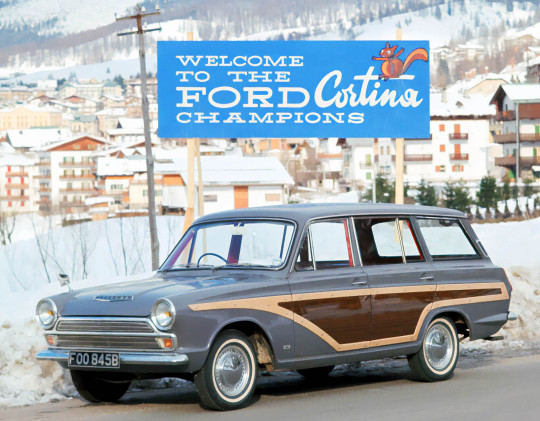#deluxe wagon
Text



1938 Ford Deluxe Station Wagon
My tumblr-blogs:
www.tumblr.com/germancarssince1946 & www.tumblr.com/frenchcarssince1946 & www.tumblr.com/englishcarssince1946 & www.tumblr.com/italiancarssince1946 & www.tumblr.com/japanesecarssince1947 & www.tumblr.com/uscarssince1935
11 notes
·
View notes
Text




Oldsmobile F-85 Deluxe Station Wagon, 1961. The F-85 utilised GM's new Y-body architecture that it shared with the "senior compacts" from Buick and Pontiac. It also shared the 215ci alloy V8 that had been developed by Buick and that was later sold to Rover when it became superfluous to GM's requirements. Sales were disappointing and when the second generation model arrived in 1964 it dropped the Y-platform's innovative unibody construction and alloy V8 growing in size to become an "intermediate" in order to compete with Ford's Fairlane
#Oldsmobile#Oldsmobile F-85#Oldsmobile F-85 Deluxe Station Wagon#1961#GM Y-body#General Motors#Alloy V8#215ci V8#senior compact#Rockette V8#long roof#station wagon#dead brands
200 notes
·
View notes
Text

1954 Chrysler Windsor Deluxe Town & Country Wagon
1 note
·
View note
Text







1941 Chevrolet Special Deluxe Wood-Bodied Wagon
Issued by Danbury Mint in 2008. It is 1:24 scale.
A Limited Edition, # 2419 of 5000.
The model is finished in Maple Brown and features genuine wood panels & trim.
0 notes
Text

This is the most deluxe horse drawn wagon I've ever seen.
1 note
·
View note
Text

Ford Deluxe Station Wagon 1940. - source Amazing Classic Cars.
134 notes
·
View notes
Text

1974 Pontiac Grand Ville

1974 Pontiac Grand Ville

1974 Pontiac Grand Ville
The Pontiac Grand Ville is a full-size car that was a sub-series trim package for the Pontiac Bonneville from 1971 to 1975, which had served as Pontiac's top-trim model since 1958 while remaining below the top level Pontiac Grand Prix
The Bonneville name remained but was now downgraded, and in effect replaced the Pontiac Executive. The Grand Ville and Bonneville shared a number of trim and design elements that distinguished them from the Catalina, and the 1971-72 Grand Villes were built on a stretched-wheelbase version of the GM "B" platform that nevertheless had identical interior dimensions to all other full-size Pontiacs.
In addition to more luxurious interior trimmings, the Grand Ville had distinctive chrome trim at the front and rear to set it apart from the rest of the Pontiac line. Between 1971 and 1974 Grand Ville hardtops featured more upright "formal" C-pillar and backlight treatments that were similar to those found on contemporary GM "C" platform cars (Oldsmobile Ninety Eight and Buick Electra) and not shared with the Bonneville or Catalina. For 1974 only, the Grand Ville had unique parking lights which wrapped around the corner of the front fender. The car was often sold with deluxe appearance options, such as sport wheels and vinyl tops. Rear fender skirts were featured on the 1973 to 1975 models.
Standard equipment on Grand Ville models included a 455 cubic-inch V8 (for 1975, a 400 cubic-inch V8 was standard and the 455 optional), Turbo-Hydramatic automatic transmission, power steering and power front disc brakes. Popular options included air conditioning, power windows and driver's seat, tilt steering wheel, cruise control, AM/FM stereo with tape deck and much more. One of the rarest options available on Grand Villes and other full-sized Pontiacs during this period was the adjustable brake and accelerator pedals offered from 1974 to 1976.
The Grand Ville enjoyed moderate success from 1971 to 1973. However, the oil crisis of late 1973 and early 1974 led to gasoline shortages, long lines at filling stations, and high fuel prices. These factors sharply cut into full-sized car sales in 1974 as buyers moved towards smaller cars. For 1975, the Grand Ville became the Grand Ville Brougham and included more standard equipment than in previous years, such as power windows and a carpeted trunk. This would be the final year for the Grand Ville series, which included Pontiac's last convertible until 1983. For 1976, the Grand Ville nameplate was dropped and the lineup was renamed Bonneville Brougham, returning that nameplate back to its former full-size top trim level status.
Grand Ville convertibles were rare, with production never exceeding 5,000 units per year during the model run. From 1973 to 1975 the Grand Ville was Pontiac's only full-size convertible offering; 1971 and 1972 full-size Pontiac convertibles were offered in the entry level Catalina line as well. (There were no convertible Bonnevilles after the 1970 model year.) The rarest of the Grand Ville convertibles was the 1971 model with just under 1,800 examples built. The 1975 model was the most plentiful with just over 4,500 cars built, as being the final year of production increased demand. The Grand Ville convertible had the lowest production amongst its corporate cousins, the Oldsmobile 88 Royale, Buick Centurion and the Chevrolet Caprice Classic convertible lines.
Starting with 1973 through 1975 the Grand Ville was offered as a station wagon as the Grand Safari.
51 notes
·
View notes
Text

Pontiac Chieftain Station Wagon & Super Deluxe Catalina (1950)
#cars#cool#cool cars#car#classic car#vintage#motor#classic#drive#driving#midcentury#1950s fashion#1950s style#1950s vintage#1950s cars#1950s car#spring#weekend#friday#pontiac catalina#pontiac
99 notes
·
View notes
Text

1962 Studebaker Lark Deluxe wagon.
74 notes
·
View notes
Text
1941 Ford Super DeLuxe Station Wagon - "They Won't Believe Me" (1947)
17 notes
·
View notes
Text










1948 Plymouth Special Deluxe station wagon
41 notes
·
View notes
Text



1937 Ford Deluxe Station Wagon
My tumblr-blogs:
www.tumblr.com/germancarssince1946 & www.tumblr.com/frenchcarssince1946 & www.tumblr.com/englishcarssince1946 & www.tumblr.com/italiancarssince1946 & www.tumblr.com/japanesecarssince1947 & www.tumblr.com/uscarssince1935
10 notes
·
View notes
Text


Ford Cortina Deluxe Estate Car, 1964. The first generation Cortina wagon was offered with the option of simulated wood trim. Chief designer for the MKI Cortina was Roy Brown Jr, designer of the Edsel, who had been banished to Dagenham following Edsel's demise. The Cortina survived through 4 main generations from 1962 until 1982 and was the UK's biggest selling car for most of the 1970s
#Ford#Ford Cortina Deluxe Estate Car#Ford Cortina#Estate Car#Station Wagon#long roof#1964#1960s#woody#woody wagon#first generation#Roy Brown Jr
149 notes
·
View notes
Text






1947 Studebaker Champion Deluxe Wood-Bodied Wagon
Issued by Madison Models in 2013. It is 1:43 scale and crafted in white metal.
The Official model of the 2013 1/43 Scale Model Car Expo. A Limited Edition, # 099 of 100.
The model is finished in Winetone Maroon w/simulated wood panels and trim.
MAD 27.
7 notes
·
View notes
Text
Railway to the Danger Zone
Or "Wagon-Lit to Varna".
The 15 October entry includes a brief mention of one of the most famous trains in the world, the Orient Express. I apologise in an advance for any errors.
So, it might be worth discussing this service and giving an idea of what it would be like, part based on my own limited experiences with sleeper trains. A return trip on the Caledonian Sleeper in 2016 and an Amsterdam to Munich ride on Nightjet last year.
The Compagnie Internationale des Wagons-Lits (et des grands express européens) or The International Sleeping-Car (and European Great Expresses) Company, usually referred to by "train fiends" as CIWL, was established in 1874 by a Belgian called Georges Nagelmackers, who inspired by the Pullman sleeping cars in the United States, decided to set up a European operation. Being the son of a powerful banker and with connections with royalty (especially King Leopold II of Belgium - yes, that guy), he was able to get his first operation going in 1872.
The Orient Express from Paris Est to the Sirkeci terminus in Constantinople (now Istanbul), which initially started just going as far as Vienna in 1882 and finally got there in 1889, was just one part of a large network of trains operated by CIWL. They eventually operated services in Africa, the Middle East and East Asia too. Even Britain got in on the action with the Night Ferry.
A photo of the modern day Paris Gare de L'Est I took last month is below. This is a roughly 10-minute walk from Gare du Nord, where boat trains from the Channel ports arrived and I am sure they could have found a taxi or something to carry their baggage.

CIWL would either attach its carriages to regular trains or do their own dedicated "Trains de Luxe" of which the Orient Express was initially the latter, charging a supplement to the regular First Class fare. Locomotives were provided by the various railway companies, changing at national frontiers or at terminus stations, like Munich Central or Vienna West. Their main network was in Western Europe - travel to the Mediterranean or to various spa towns (like, well, Spa) by the upper classes being their main source of business. They also managed to corner the restaurant car business in mainland Europe for several decades.
It's worth mentioning that the Orient Express service here is not the more famous train from the Agatha Christie novel. That was the Simplon Orient Express, a post-First World War train routed via Switzerland (the Simplon Tunnel), Italy and Yugoslavia to avoid going through the losing countries of the Great War - for one thing, the Germans had seized a good deal of CIWL's rolling stock and set up a rival operation called Mitropa.
The Orient Express here had the routing of Paris-Munich-Vienna-Budapest-Bucharest-Varna-Istanbul, at least initially. The 1888 timetable can be found here:
As you can see, it only went through to Constantinople (via ship from Varna at this time) twice a week; most of the carriages would have only go as far as Vienna. I am not sure of the actual arrangements in 1893 and if a change would be required at Bucharest. The train would not be massively long - maybe six carriages total.
While luxurious and elegantly decorated, the provisions of your 1890s sleeper compartment were limited and the compartments rather small. The 2000s-built Nightjet version from Amsterdam to Munich might serve as a useful illustration. This is the standard compartment; the deluxe ones with toilet and shower had sold out. Sleepers are very popular right now!

The seats convert into bunk beds for sleeping, something still done done by a smartly dressed conductor. You got a sheet and a branded woolen blanket. Indeed, the modern-day successor to CIWL, Newrest Wagons-Lit, provides the staff for the Nightjet network. This compartment has three beds total - the 1890s train had a mix of 2-berth and four-berth compartments.
More photos of the modern-day carriage can be found here:
While there was an en-suite washbasin provided in each compartment with a mirror for shaving, if you needed to go to the toilet, you had to go down the corridor. This would have been something familiar to Lord Godalming from his boarding school days. No WiFi - even on most trains today that's the case.
Most of the photographs of CIWL rolling stock are from the 1920s onwards, when they used steel carriages painted blue; the 1890s carriages were in teak and looked roughly like this:
Space for larger luggage is limited and these trains had dedicated luggage cars. In Western Europe, customs/passport inspections would be handled by the conductor during the night, because the last thing you want to do is wake up someone like Baron Renfrew. Especially as that guy was the Prince of Wales travelling incognito and he could have a ferocious temper. Although to be fair, he would usually be extra nice afterwards.
Restaurant coaches were generally only found on trains with significant daytime portions (frequently only for those bits), a waste of money and coal otherwise. Otherwise, you would have a tray brough to your room. A carafe of water was provided, and the conductor could sell you something a bit stronger. The food would have been rather good in any event; my Nightjet and Caledonian Sleeper meals made up for a lot of the problems.
Then it would be a case of riding through the night, the clickety-clack of jointed track hopefully helping you sleep.
The OG service, soon being routed via Belgrade instead, continued to run except for wartime interruptions, gradually contracting after the Second World War as the Iron Curtain and air travel put people off it, until 2009, ending as just a Strasbourg-Vienna EuroNight.
However, Nightjet now do a thrice-weekly Paris to Vienna service, which as a nice nod to the past uses the same numbers (469/468) the Orient Express used in its final years.
The First World War saw CIWL's carriages requisitioned for military use and the Armistice would be signed on one of their carriages used as part of Ferdinand Foch's staff train at Compiègne in France on 11 November 1918. Hitler would then use that same carriage for the surrender of France in 1940, taking it back to Germany where it was destroyed - a modified vehicle from the same class stands on the site today.
CIWL itself would go on (despite the loss of its Russian operations in particular) to reach its peak in the early 1930s before the Second World caused more loss of rolling stock. After that, their Central and Eastern European operations were nationalised and with the market in decline, they eventually sold or leased their carriages in 1971 to a consortium of Western European operators. They continued to build and maintain carriages until 1998 and some of their stuff can still be found in Europe today, especially on the private sleeper operators like the Alpen-Sylt Express. They also continued to staff these trains and still do with Newrest Wagons-Lit.
My trips did not see me get the greatest night's sleep and I had a big delay on the Nightjet, but it was a memorable experience and I intend to do another overnight train next year.
More details of that can be found here if interested:
So, yes. A good train ride ahead of a dangerous operation.
#dracula daily#dracula#history#trains#Why did they give Constantinople the works?#It's nobody's business but the Turks#orient express#CIWL#nightjet
81 notes
·
View notes
